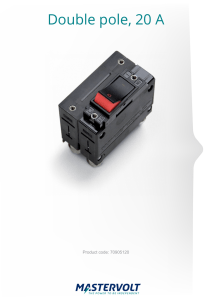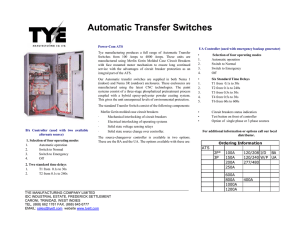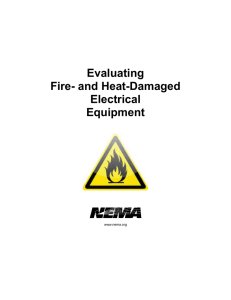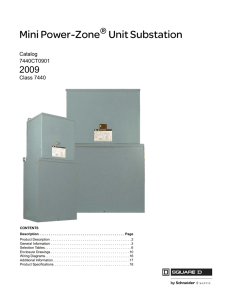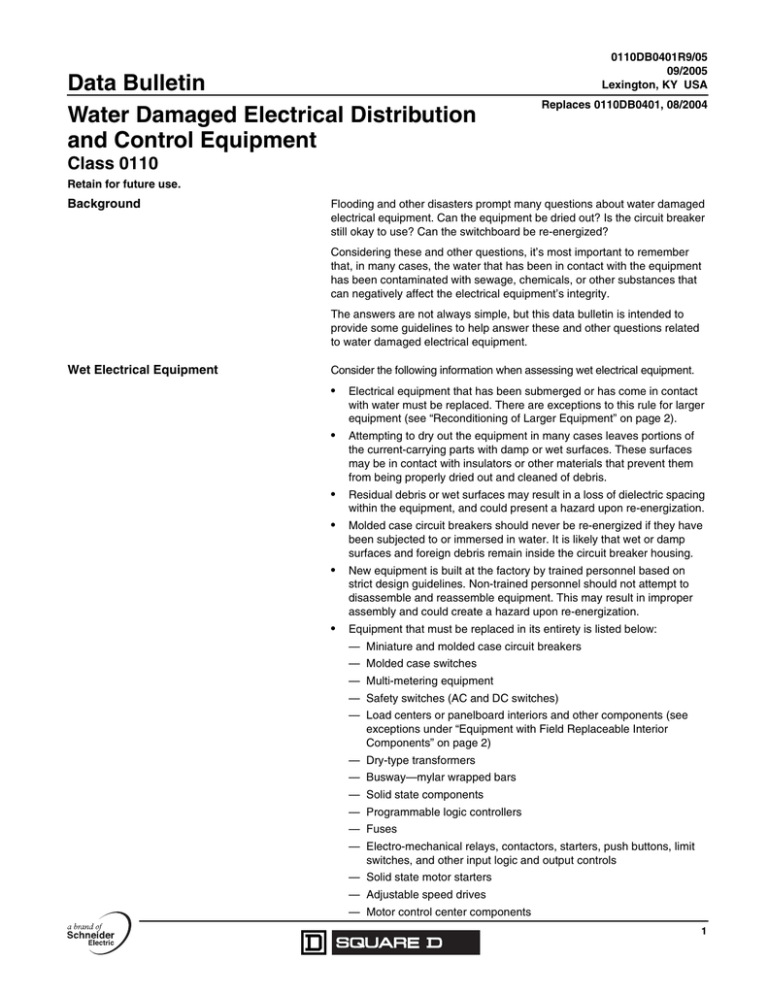
Data Bulletin
Water Damaged Electrical Distribution
and Control Equipment
0110DB0401R9/05
09/2005
Lexington, KY USA
Replaces 0110DB0401, 08/2004
Class 0110
Retain for future use.
Background
Flooding and other disasters prompt many questions about water damaged
electrical equipment. Can the equipment be dried out? Is the circuit breaker
still okay to use? Can the switchboard be re-energized?
Considering these and other questions, it’s most important to remember
that, in many cases, the water that has been in contact with the equipment
has been contaminated with sewage, chemicals, or other substances that
can negatively affect the electrical equipment’s integrity.
The answers are not always simple, but this data bulletin is intended to
provide some guidelines to help answer these and other questions related
to water damaged electrical equipment.
Wet Electrical Equipment
Consider the following information when assessing wet electrical equipment.
•
Electrical equipment that has been submerged or has come in contact
with water must be replaced. There are exceptions to this rule for larger
equipment (see “Reconditioning of Larger Equipment” on page 2).
•
Attempting to dry out the equipment in many cases leaves portions of
the current-carrying parts with damp or wet surfaces. These surfaces
may be in contact with insulators or other materials that prevent them
from being properly dried out and cleaned of debris.
•
Residual debris or wet surfaces may result in a loss of dielectric spacing
within the equipment, and could present a hazard upon re-energization.
•
Molded case circuit breakers should never be re-energized if they have
been subjected to or immersed in water. It is likely that wet or damp
surfaces and foreign debris remain inside the circuit breaker housing.
•
New equipment is built at the factory by trained personnel based on
strict design guidelines. Non-trained personnel should not attempt to
disassemble and reassemble equipment. This may result in improper
assembly and could create a hazard upon re-energization.
•
Equipment that must be replaced in its entirety is listed below:
— Miniature and molded case circuit breakers
— Molded case switches
— Multi-metering equipment
— Safety switches (AC and DC switches)
— Load centers or panelboard interiors and other components (see
exceptions under “Equipment with Field Replaceable Interior
Components” on page 2)
— Dry-type transformers
— Busway—mylar wrapped bars
— Solid state components
— Programmable logic controllers
— Fuses
— Electro-mechanical relays, contactors, starters, push buttons, limit
switches, and other input logic and output controls
— Solid state motor starters
— Adjustable speed drives
— Motor control center components
1
Water Damaged Electrical Distribution and Control Equipment
Data Bulletin
Reconditioning of Larger Equipment
0110DB0401R9/05
09/2005
For certain types of equipment, disassembly may be performed by trained
factory service personnel who are familiar with the equipment design and
function. The Square D® Customer Information Center (CIC) can help in
evaluating this equipment, and can make recommendations and discuss the
next appropriate phase of recovery with customers. The number for the CIC
is 1-888-SquareD (1-888-778-2733).
Equipment that may be reconditioned includes:
•
Switchboard enclosures and bus structure (depends on bus structure
arrangement and types of insulating materials used)
•
•
•
•
•
•
Switchgear
•
•
•
•
Panelboard and load center enclosures
Low-voltage power circuit breakers1
Medium voltage circuit breakers
Low voltage bolted-pressure switches1
Medium voltage switches
Motor control center enclosures and bus structure (depends on bus
structure arrangement and type of insulating materials used)
Liquid-filled power transformers
Cast-resin transformers
Busway—epoxy coated bars
Reconditioning of this equipment may include repair or replacement of
internal components. This service should only be performed by qualified
personnel familiar with the operation and construction of such equipment. The
ability to recondition this equipment will vary depending on equipment age,
contamination level of the water, and the length of time in contact with water.
Equipment with Field Replaceable
Interior Components
Generally, this type of replacement is limited to a load center or panelboard
type of product where the entire assembly can be removed and replaced as
a unit.
Enclosures possibly can be reused in this case if they have not been
subjected to physical damage and if they have been properly cleaned of all
debris and foreign materials.
Contact your local Schneider Electric/Square D representative for possible
replacement interior assemblies.
Equipment with mechanical components that cannot be field replaced, such
as a safety switch, must be removed and replaced in its entirety. These
mechanical components are critical to proper operation of the equipment
and may have sustained damage.
1
2
Low voltage power circuit breakers and bolted-pressure switches cannot be dried out and
cleaned. They must be repaired with new parts including mechanisms, trip units/fuses, and
other electrical components.
© 1993–2005 Schneider Electric All Rights Reserved
Water Damaged Electrical Distribution and Control Equipment
Data Bulletin
Cleaning Agents and Abrasives
0110DB0401R9/05
09/2005
Do not apply cleaning agents, particularly petroleum-based cleaners such
as WD-40® and CRC®, to the current-carrying portions of electrical
equipment to remove foreign debris, residues, and other substances. This
practice can be hazardous and should be avoided.
Some cleaning and lubricating compounds can cause deterioration of the
non-metallic insulating or structural portions of the equipment (see National
Electrical Code® 110.11 FPN No. 2).
Do not use abrasives such as sandpaper or steel wool to clean
current-carrying parts of the equipment. These materials may remove
plating or other conductive surfaces from the parts, which could result in a
hazard when the equipment is re-energized.
Non-Submerged Equipment in Flooded
Areas
Equipment in this situation should be inspected carefully by a qualified
person to determine whether moisture has entered the enclosure. If any
signs of moisture or damage exist, the equipment should be replaced or
repaired, as previously described.
Other References
•
NEMA Standard AB 4-2003, Guidelines for Inspection and Preventive
Maintenance of Molded Case Circuit Breakers Used in Commercial and
Industrial Applications
•
NEMA Standard BU 1.1-2000, General Instructions for Proper Handling,
Installation, Operation, and Maintenance of Busway Rated 600 Volts
or Less
•
NEMA Standard PB 1.1-2002, General Instructions for Proper Installation,
Operation, and Maintenance of Panelboards Rated 600 Volts or Less
•
NEMA Standard PB 2.1-2002, General Instructions for Proper Handling,
Installation, Operation, and Maintenance of Deadfront Distribution
Switchboards Rated 600 Volts or Less
•
NEMA Standard ICS 1.1-2003, Industrial Control and Systems: Safety
Guidelines for the Application, Installation, and Maintenance of Solid
State Controls
Other Considerations
Consideration must be given to other components in the electrical system
such as conductors, connected utilization equipment, connections in
junction boxes, etc.
Summary
In general, water damaged equipment must be replaced. It is important to
the entire electrical system that distribution and control equipment function
properly. Equipment or components that have been replaced due to water
damage should be destroyed; they should not be reused in
another application.
The Square D® Customer Information Center can answer any questions you
have about water damaged equipment. In addition, the CIC offers a variety of
services, including inspecting, testing, and reconditioning of electrical
equipment. Contact the CIC or your local Schneider Electric/Square D
representative by calling 1-888-SquareD (1-888-778-2733).
Schneider Electric USA
1601 Mercer Road
Lexington, KY 40511 USA
1-888-SquareD (1-888-778-2733)
www.us.SquareD.com
Electrical equipment should be installed, operated, serviced, and maintained only by
qualified personnel. No responsibility is assumed by Schneider Electric for any
consequences arising out of the use of this material.
© 1993–2005 Schneider Electric All Rights Reserved

